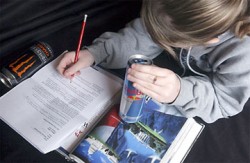 Young people are being exposed to a massive amount of marketing for sugary drinks, such as full-calorie soda, sports drinks, energy drinks, and fruit drinks, according to a new study from the Yale Rudd Center for Food Policy and Obesity. The report’s authors studied marketing by 14 beverage companies and examined the nutritional quality of nearly 600 products including full-calorie soda, energy drinks, fruit drinks, flavored water, sports drinks, and iced teas, as well as diet energy drinks and diet children’s fruit drinks. Key study findings include:
Young people are being exposed to a massive amount of marketing for sugary drinks, such as full-calorie soda, sports drinks, energy drinks, and fruit drinks, according to a new study from the Yale Rudd Center for Food Policy and Obesity. The report’s authors studied marketing by 14 beverage companies and examined the nutritional quality of nearly 600 products including full-calorie soda, energy drinks, fruit drinks, flavored water, sports drinks, and iced teas, as well as diet energy drinks and diet children’s fruit drinks. Key study findings include:
Companies are targeting black and Hispanic children and teens:
- Black children and teens saw 80 percent to 90 percent more ads compared with white youth, including more than twice as many for Sprite, 5-hour Energy, and Vitamin Water.
- From 2008 to 2010, Hispanic children saw 49 percent more ads for sugary drinks and energy drinks on Spanish-language TV, and Hispanic teens saw 99 percent more ads.
Many fruit drinks and energy drinks have as much added sugar and calories as full-calorie soda:
- An 8-ounce serving of a full-calorie fruit drink has 110 calories and 7 teaspoons of sugar – the same amount found in an 8-ounce serving of a full-calorie soda or energy drink.
- Children ages 4 to 8 should consume no more than 15 grams of added sugar per day, according to Choosemyplate.gov and the American Heart Association. Given that there are at least 15 grams of sugar per serving in two-thirds of the drinks marketed to children, these drinks contribute to excess sugar consumption. Even 6-ounce child-sized drink pouches like Capri Sun Originals have about 14 grams of added sugar.
Energy drinks are inappropriate for children and teens, yet they are heavily marketed to them:
- The American Academy of Pediatrics says that highly caffeinated energy drinks “have no place in the diet of children and adolescents.” Despite this medical advice, the companies clearly target teens.
- In 2010, teens saw 18 percent more TV ads and heard 46 percent more radio ads for energy drinks than adults did. Teens also saw 20 percent more TV ads for energy drinks in 2010 than they saw in 2008. The full report and tools for consumers and researchers are available at www.sugarydrinkfacts.org.







